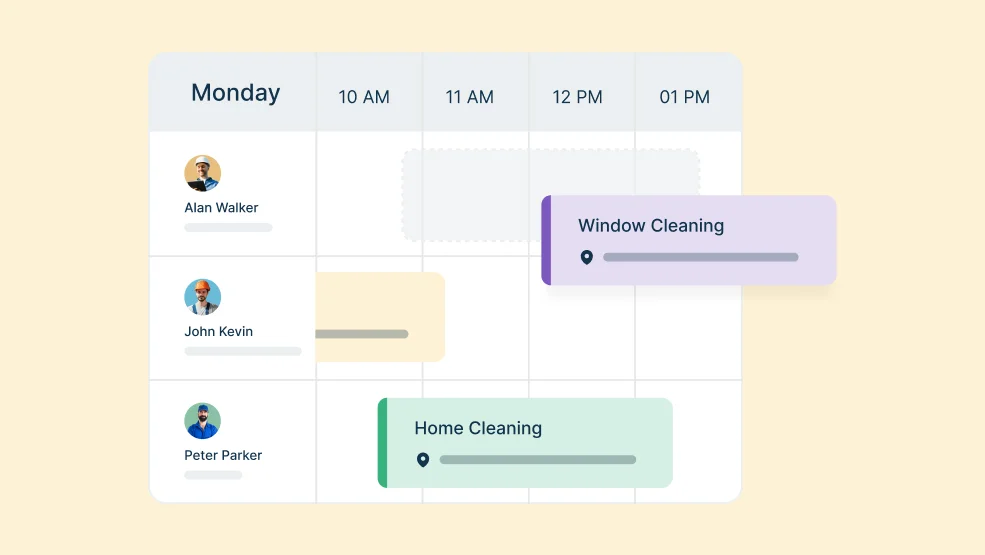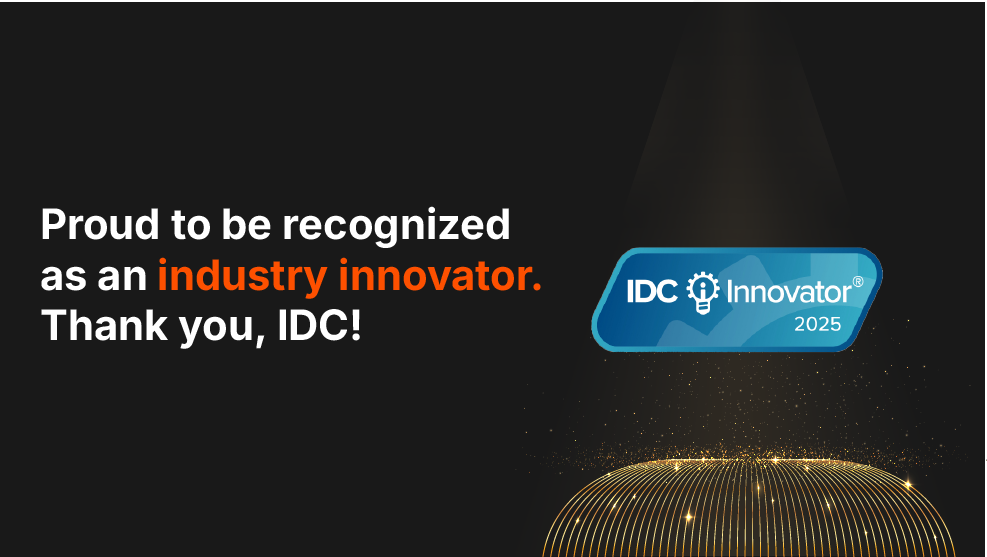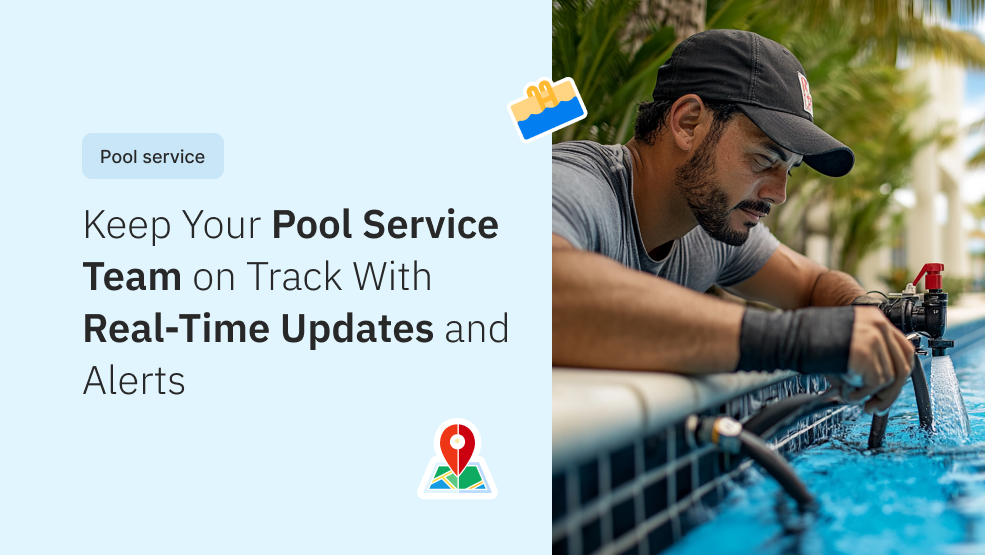In today’s competitive landscape, maximizing resource utilization across multiple locations is crucial for operational efficiency and profitability. In a fast-paced, customer-centric environment, efficiency is everything. Juggling multiple locations, technicians, and customer requests can be a logistical nightmare. What if there was a way to streamline your operations and ensure your resources are always used to their full potential? Here is where resource optimization plays an important role; this strategic approach involves allocating resources most efficiently. Careful assignment of technicians, vehicles, and equipment can minimize travel time, reduce idle periods, and ultimately deliver faster, more cost-effective service to your customers.
Resource optimization is the key to maximizing efficiency and productivity. It’s about strategically allocating and utilizing your resources—technicians, equipment, and time to achieve the best possible outcomes. This translates to assigning the right technicians with the necessary skills and equipment to the right jobs at the right time across multiple locations. You can increase customer satisfaction and operational efficiency by optimizing resource allocation and ensuring timely service delivery.
How do you achieve optimal resource utilization across multiple locations? That’s where this guide comes in. Whether you’re a seasoned manager or just starting, this guide will equip you with the knowledge and tools you need to take your resource management to the next level. So, buckle up and get ready to discover how to make the most of your resources, no matter where your business takes you. This article gets into the concept of resource optimization, exploring its importance, challenges, and effective strategies for implementation. We’ll discuss the role of dispatch boards and the latest trends in resource management, empowering field service professionals to optimize their operations across multiple locations. With the worldwide revenue for the data asset management market predicted to grow by 15.6% between 2017 and 2025, adopting technological solutions to help boost business operations is a good idea.
The importance of resource optimization in your business
In this competitive business landscape, optimizing resource allocation is not just a suggestion; it’s a necessity. Companies reap significant benefits by strategically assigning the right technicians to the right jobs at the right time across multiple locations; let’s look at a few of them below.
Increased efficiency
Minimized travel time and reduced idle periods lead to faster service delivery and improved customer satisfaction. Imagine a scenario where technicians constantly backtrack or travel long distances between jobs. This not only wastes valuable time but also frustrates customers who are waiting for service. By optimizing resource allocation, dispatchers can ensure that technicians are assigned jobs that are geographically close to their current location and align with their skill set. This leads to faster response times, shorter service times, and, ultimately, happier customers.
Reduced costs
Efficient resource utilization translates to significant cost savings for your business. By optimizing job assignments, you can minimize travel expenses and reduce unnecessary travel time, which means lower fuel costs and vehicle wear and tear. When technicians are efficiently assigned to jobs, the need for overtime work is reduced, saving on labor costs. By ensuring technicians are consistently busy with the right jobs, you avoid situations where they are underutilized and not contributing to their full potential. Optimizing resource allocation is not just about efficiency; it’s also about making wise financial decisions that can contribute to the overall profitability of your business.
Improved customer satisfaction
In any business, customer satisfaction must be the priority. Timely and efficient service delivery is a key factor in achieving this. By optimizing resource allocation, you can ensure your technicians arrive on time and your customers don’t have to wait long for service, reducing frustration and improving their overall experience. Efficient job assignments based on technician skills lead to fewer errors and rework, minimizing the need for repeat visits. Clear communication throughout the service process keeps customers informed and reduces anxiety. Your commitment to customer satisfaction will help you build solid and long-lasting relationships with your clients. This translates to increased loyalty and repeat business, driving sustainable growth for your business.
Enhanced scalability
Adapting to changing demands and expanding into new territories becomes crucial as your business grows. By optimizing resource allocation, you can efficiently manage peaks and valleys in service demand, ensuring you have the right resources available when and where they’re needed. Confidently enter new markets without worrying about resource constraints. Optimize your existing resources and consider strategic hiring to support your expansion. Optimizing resource allocation provides the flexibility and agility needed to scale your business effectively. This allows you to capitalize on new opportunities and reach a broader customer base, ultimately driving sustainable growth and success.
Challenges you might run into while optimizing resource utilization
While resource optimization significantly benefits your business, several factors can hinder its successful implementation. The lack of real-time data on technician availability, skills, and location can lead to inefficient job assignments. Manual scheduling processes can be time-consuming, prone to errors, and unable to account for dynamic changes in real-time. Dispatchers may struggle to make informed decisions without a comprehensive overview of resources and job requirements across multiple locations. Inefficient communication between dispatchers, technicians, and customers can lead to delays and missed appointments. Let us look at this in more detail.
Lack of real-time data
One of the biggest challenges to achieving optimal resource utilization is the lack of accurate and real-time data on technician availability, skills, and location. Without this information, dispatchers are forced to make decisions based on outdated or incomplete data. Technicians may be assigned to jobs they are not qualified for, leading to delays in work and potentially an increase in rework—resulting in dissatisfied customers. Unnecessary travel, where dispatchers send technicians on lengthy trips, wastes time and resources. Inaccurate location data can cause missed appointments, frustrating customers, and damaging your reputation. Investing in reliable data collection and management systems is crucial to overcoming this challenge and ensuring efficient resource allocation.
Manual scheduling
Traditional, manual scheduling processes can be a significant obstacle to achieving optimal resource utilization, and they are often time-consuming. Manually assigning jobs and tracking technician availability can be lengthy and tedious, taking time away from other tasks. Manual scheduling is also prone to human error, leading to mismatched assignments, missed appointments, and wasted time. They cannot adapt to real-time dynamic changes, such as sudden service requests or unexpected delays, leading to inefficiencies and missed opportunities. Implementing automated scheduling software can streamline the process, minimizing errors and ensuring that resources are allocated efficiently based on real-time data and changing circumstances.
Limited visibility
Limited visibility into the overall resource landscape can be a significant hurdle when your business operates out of multiple locations. A comprehensive overview of available technicians, skillsets, and current locations is crucial for efficient job assignment. Understanding each job’s specific needs and requirements ensures that the right technician with the necessary skills and equipment is assigned. A clear picture of technician distribution across different locations helps optimize travel time and minimizes unnecessary trips. Without this visibility, dispatchers may struggle to make informed decisions about resource allocation, leading to inefficiencies and missed opportunities.
Communication gaps
Inefficient communication between dispatchers, technicians, and customers can significantly hinder optimal resource utilization. Lack of clear communication about job details, arrival times, and potential issues can lead to delays and disruptions in the service process. If customers are not informed about technician schedules or unexpected delays, missed appointments are more likely to occur, causing frustration and inconvenience. Without clear communication, technicians might not have all the necessary information to resolve customer issues effectively, leading to rework and repeat visits. Implementing effective communication strategies and utilizing technology tools can help bridge these gaps and ensure everyone involved is informed and on the same page, contributing to improved resource utilization.
5 strategies to maximize resource optimization across multiple locations

How maximizing resource optimization is suitable for businesses
By implementing the strategies outlined above and embracing resource optimization, your business can unlock many benefits that contribute to its overall success. Optimized resource allocation minimizes travel time, overtime, and underutilized personnel, leading to significant cost savings. Faster service delivery, reduced wait times, and efficient job completion directly impact customer satisfaction, fostering loyalty and repeat business. Improved efficiency and customer satisfaction translate to increased revenue opportunities and business growth. Optimized resource management enables companies to readily adapt to changing service demands and expand operations into new territories. By prioritizing resource optimization, businesses can achieve greater efficiency, reduce costs, and ultimately, build a more prosperous and sustainable business.
How using Zuper can help manage your resources better
Using software like Zuper empowers businesses to overcome the challenges associated with manual processes and limited visibility, enabling them to achieve optimal resource utilization. Offering a range of features designed to streamline scheduling, improve communication, and provide valuable data insights.
Smart scheduling
Smart scheduling is revolutionizing the way businesses manage their resources. This innovative approach leverages data and technology to automate job assignments, ensuring efficiency and effectiveness. Gone are the days of manual scheduling and guesswork; smart scheduling provides real-time visibility into technician availability, skills, and location. This allows dispatchers to make informed decisions and assign tasks to the most suitable technicians based on their expertise and proximity to the job site. With smart scheduling, you gain complete control and transparency. You know exactly who is assigned to what job, when they’re expected to arrive, and their real-time progress. This empowers you to optimize resource allocation, minimize travel time, and ensure timely service delivery, ultimately leading to happier customers and a more profitable business.

Real-time location tracking
Real-time location tracking has become invaluable for many businesses, offering significant customer support and service delivery benefits. By leveraging GPS technology, dispatchers and customer support representatives can instantly access the location of technicians, where customers are kept informed about the technician’s estimated arrival time, reducing anxiety and improving their overall experience. Optimized route planning helps dispatchers dynamically adjust routes based on real-time traffic conditions and technician location, ensuring the most efficient travel time and minimizing delays. Knowing the technician’s location allows for proactive communication with customers, setting realistic expectations, and addressing potential concerns. Ultimately, real-time location tracking fosters transparency and builds customer trust, increasing satisfaction and a more positive service experience.
![]()
Improved communication
Effective communication is the cornerstone of successful operations. Zuper takes communication to the next level by providing tools that keep everyone informed and connected. Zuper’s automated reminders keep customers updated throughout the service process, starting with job creation and continuing with dispatch notifications, payment receipts, and follow-up surveys. This proactive communication reduces customer anxiety, fosters trust, and ensures technicians know each job’s details and expectations. Zuper’s in-app chat feature facilitates real-time communication between dispatchers and technicians, allowing for quick resolution of any issues that may arise during the service call. This streamlined communication loop enhances transparency, improves collaboration, and creates a more efficient and satisfying experience for all parties involved.
Data-driven insights
Efficient software goes beyond simply automating tasks; it provides a wealth of data-driven insights that empower field service companies to continuously improve their operations. Comprehensive reporting and analytics offer a clear picture of resource utilization patterns, highlighting areas for optimization and strategic decision-making. The software allows flexible report customization, enabling users to tailor data analysis to specific needs and use cases. With drag-and-drop functionality and multiple filtering options, you can quickly drill down into specific metrics and better understand your business performance. Real-time access to financial reports lets you track projected revenues, manage invoices, and monitor payment history. Zuper’s dynamic dashboard also provides a visual overview of key business metrics, allowing you to track progress and identify trends across different timeframes. By leveraging these data-driven insights, field service companies can make informed decisions, optimize resource allocation, and achieve sustainable growth.
Maximizing resource optimization is the key to success
With continuous advancements in technology and data analytics, the future of resource optimization looks bright. We expect to see further integration of artificial intelligence and machine learning for even more intelligent and automated resource allocation. The rise of the Internet of Things (IoT) will provide real-time data on equipment health and technician performance, further enhancing optimization efforts. Modern technology and data-driven insights are critical drivers of successful resource optimization. Implementing robust software with automated scheduling, real-time tracking, and integrated communication tools streamlines the process, eliminates manual errors, and provides real-time data for informed decision-making.

Additionally, historical data and real-time analytics offer valuable insights into resource utilization patterns, enabling businesses to identify areas for improvement, optimize scheduling, and predict future resource needs. By embracing resource optimization as a strategic priority, businesses can unlock a world of possibilities. Improved efficiency, reduced costs, and enhanced customer satisfaction pave the way for sustainable growth and success in the ever-evolving field service industry. Schedule a demo with us today.






